Tomatoes are one of the most demanding vegetable crops. This fact becomes especially relevant when plants are cultivated in closed ground, that is, in a greenhouse. Greenhouse tomatoes vitally need full feeding — a complex of organic and mineral fertilizers.
Since growing tomatoes in a greenhouse is a real chance to bring the harvest forward by a couple of months, let’s look at what is especially important during the feeding of tomatoes in a greenhouse, which fertilizers to use and when.
Table of contents
How to Feed Tomatoes in a Greenhouse
The most important elements for feeding tomatoes are nitrogen, potassium, and phosphorus.
Most often, gardeners who grow tomatoes for personal use rely on organic fertilizers. In commercial farming, a simpler and cheaper method is used — mineral fertilizers (magnesium sulfate, "Universal Compo").
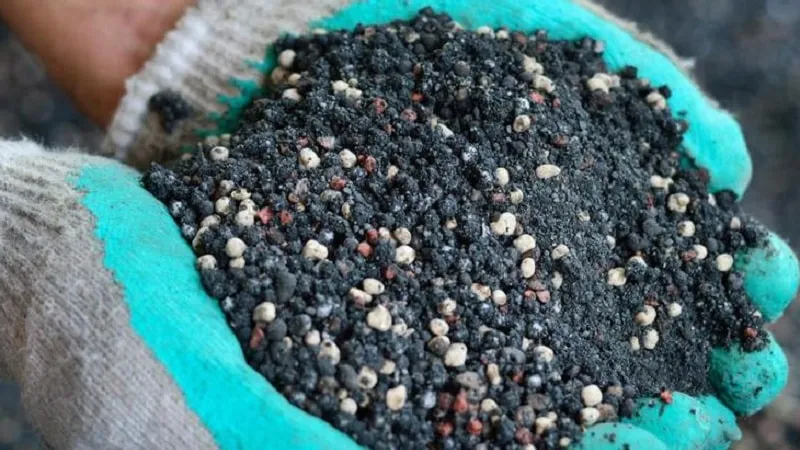
However, the best option for fertilizing vegetable crops is to use both organic and mineral types of fertilizers. In this case, plants receive all the essential micronutrients they need for full growth and development.
Conclusion. It’s best to alternate organic and mineral fertilizers.
Fertilization Schedule
The first feeding is carried out even before transplanting seedlings into the greenhouse. For 1 m², use a bucket of compost or manure and two cups of wood ash. Thanks to these organic substances, the soil is enriched with nitrogen, potassium, phosphorus, and other micronutrients.
Fertilizers at Different Growth Stages
Vegetable crops require different fertilizers at each stage of their development.
Transplanting Seedlings and Bush Maturation
During the transplanting period, there is no need to add large amounts of fertilizer to the soil, as the soil already contains all the necessary micronutrients for future seedlings (compost, manure, ash). Within a week, the vegetable crop will adapt to the soil, after which the first leaves will appear.
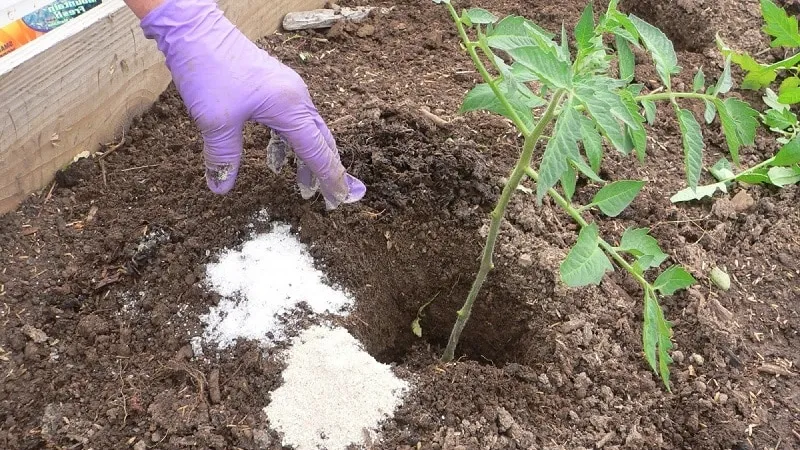
After 2 weeks, a mineral feeding can be applied using substances containing phosphorus (40 g), potassium (15 g), and nitrogen (25 g). The substances are diluted in 10 liters of water, and 1 liter is used per plant.
Important! During this period, do not overuse fertilizers, including organic ones. If you overfeed (e.g., with manure), the stems will become thick, the leaves large, but the fruits — small and few in number.
Flowering and Fruit Set
 After transplanting seedlings into the greenhouse, do not rush to feed the plants. Wait a week and observe how well the bushes take root. When the plant begins to flower en masse, it’s time to apply fertilizers.
After transplanting seedlings into the greenhouse, do not rush to feed the plants. Wait a week and observe how well the bushes take root. When the plant begins to flower en masse, it’s time to apply fertilizers.
During flowering, a mixture of organic fertilizer (manure) and potassium sulfate is suitable. You can also use a mineral fertilizer like "Universal Compo".
When the plant begins to bear fruit and the fruits ripen, it especially needs potassium. Potassium accelerates the redistribution of nutrients and their delivery to the developing fruits.
Note! During this period, the plant also particularly needs nitrogen and phosphorus.
Fruit Growth
During fruit ripening, observe how the plant develops. If the stem stops growing and the leaves become dull, repeat the feeding. Dissolve 1 tbsp of sodium humate and 2 tbsp of superphosphate in a bucket of water. This solution will help tomatoes grow faster.
If the plant is developing well, no additional feeding is needed.
Types of Fertilization
Plant fertilization is divided into two types: foliar and root.
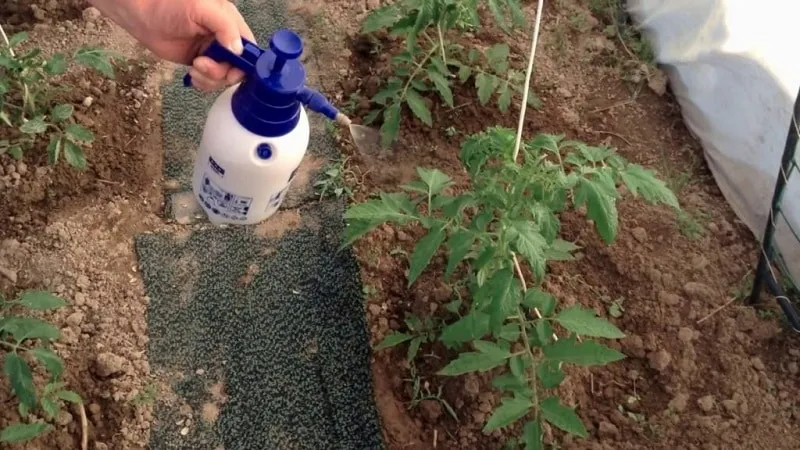
Foliar Feeding
Foliar feeding is necessary if you want to increase plant productivity. Do not overuse this type of feeding — apply it only when needed.
Feeding is carried out in warm weather with open vents.
If tomatoes suffer from boron deficiency (bushes flower but do not set fruit), spray the plants with a boron solution (2 g of boric acid dissolved in 10 liters of water). Iodine protects the plant from phytophthora. Add 10 drops of iodine to 10 liters of water.
Root Feeding
Root feeding is applied at all stages of plant growth and fruit formation. It can be organic (compost, manure) or mineral (potassium sulfate, sodium humate, superphosphate).
Traditional Methods
Organic fertilizers for feeding tomatoes are especially popular among gardeners:
- Wood ash. Used to strengthen the root system, contains nitrogen, potassium, and phosphorus. To prepare the solution, take 10 liters of water and two cups of ash. Mix and leave in a dark place for a week. Then water the tomatoes.
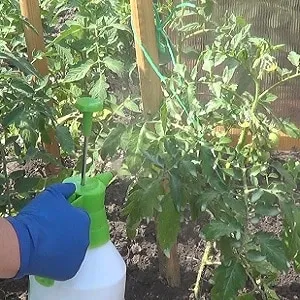 Yeast. Organic feeding boosts plant immunity and fruiting, helps withstand heat. To prepare the solution, use dry powder or granulated yeast. Add 100 g of the substance to a bucket of warm water. Once a week, pour 1 liter of the solution under each plant.
Yeast. Organic feeding boosts plant immunity and fruiting, helps withstand heat. To prepare the solution, use dry powder or granulated yeast. Add 100 g of the substance to a bucket of warm water. Once a week, pour 1 liter of the solution under each plant.- Herbal infusions. The advantage of herbal infusions is that tomatoes receive nitrogen in an easily digestible form. Any plastic container is suitable for the infusion. Fill 2/3 of the container with grass (without seeds). Then add water, leaving 5-10 cm from the top. Cover the container with film and leave for 2 weeks. Dilute the solution with water (1:10) and water the roots.
- Compost. One of the best fertilizers for tomatoes — improves soil fertility. However, this organic matter must be prepared a year before transplanting seedlings into the greenhouse. Suitable ingredients include freshly cut grass, weed-free plants, food waste, hay, sawdust, eggshells, and more. Layer these materials in a dedicated compost bin. Over a year, biochemical reactions occur, resulting in nutrient-rich organic fertilizer. Apply compost before transplanting or in autumn.
- Manure. A valuable nutrient for vegetable crops. Apply manure to the soil in autumn after harvest. By the time of transplanting, the ammonia content in the soil will decrease. Use 5 kg of manure per 1 m².
- Poultry manure is also applied to the soil in autumn after harvest.
Mineral Fertilizers
Mineral fertilizers contain substances necessary for plant growth and fruit development. They can be single-component or complex.
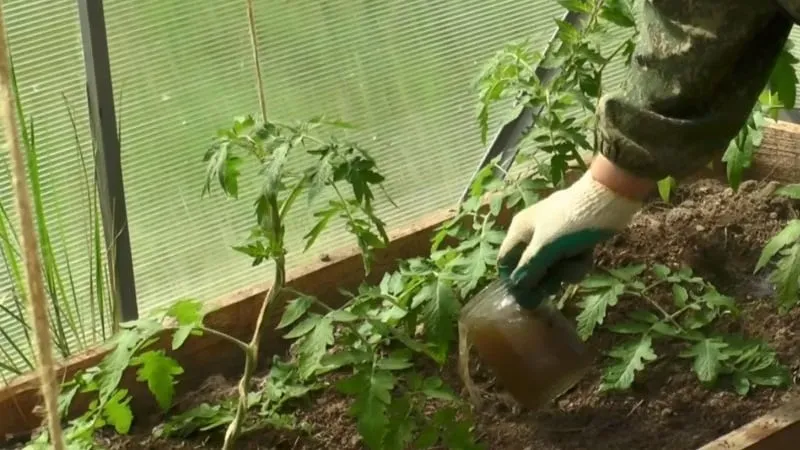
Best Fertilizers and Application Rules
The most effective complex mineral fertilizers for plants:
- NPK fertilizer. Rich in phosphorus, nitrogen, and potassium. Directly affects yield. Dissolve 50 g of NPK in 10 liters of water until granules disappear. Pour the solution into each planting hole (1 liter per plant).
- Calcium nitrate. Rich in calcium and nitrogen, promotes intensive plant growth and fruit development. Dissolve 20 g of fertilizer in a bucket of water. Apply the first root feeding 7 days after transplanting, then weekly until flowering.
- Monoammonium phosphate. High in phosphorus. Stimulates fruiting and root development. Can be applied dry (into the soil 10 cm from the stem) or as a root solution.
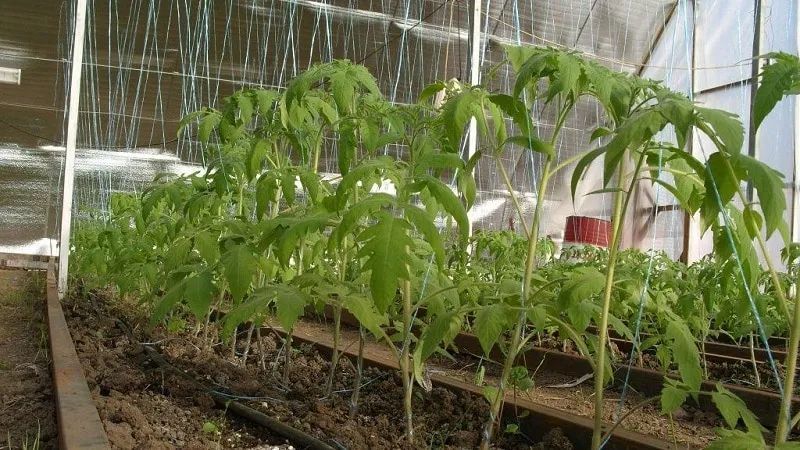
How to Identify Nutrient Deficiencies
To avoid unnecessary fertilization, learn to recognize plant needs:
- Phosphorus — plants struggle in cold weather, disease resistance drops sharply;
- Potassium — deficiency affects fruit taste and root health;
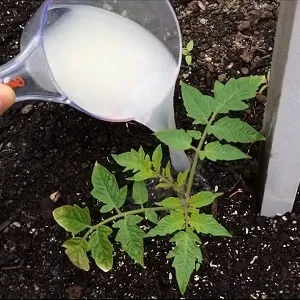 Nitrogen — yellowing leaves, stunted growth, weak roots, reduced yield;
Nitrogen — yellowing leaves, stunted growth, weak roots, reduced yield;- Calcium — curled leaves;
- Magnesium and zinc — dome-shaped, small leaves with yellow spots;
- Sulfur — wilting, yellowing from the top;
- Boron — poor fruit set;
- Copper — limp, whitish leaves, new growth has a bluish tint;
- Manganese — mottled leaves with dark veins;
- Molybdenum — spotted leaves, edges curling inward or dying;
- Iodine — susceptibility to fungal infections (brown spot, phytophthora, root rot).
Tips from Experienced Farmers
For optimal tomato growth and yield, follow these recommendations from experienced farmers:
- Avoid planting tomatoes in overly fertilized soil.
- Apply the first feeding to transplanted tomatoes in early June.
- Do not use manure more than twice per season.
- The best seedling feed — liquid organic fertilizer (e.g., vermicompost). Dilute as instructed, add some ash, and water the plants.
- For emergency nutrient delivery, use foliar feeding.
Conclusion
When feeding tomatoes, use both organic and mineral fertilizers, but avoid unnecessary overfeeding — adjust based on growth stage and plant needs.
Monitor plant health throughout growth. Poor leaf or root condition indicates deficiencies. Nitrogen, phosphorus, and potassium are the three essential elements required at every development stage.







